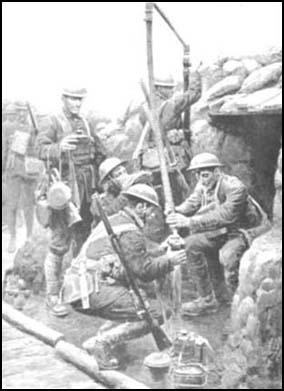Dysentery
Dysentery is a disease involving the inflammation of the lining of the large intestines. The inflammation causes stomach pains and diarrhoea. Some cases involve vomiting and fever. The bacteria enters the body through the mouth in food or water, and also by human feaces and contact with infected people. The diarrhoea causes people suffering from dysentery to lose important salts and fluids from the body. This can be fatal if the body dehydrates. This disease struck the men in the trenches as there was no proper sanitation. Latrines in the trenches were pits four to five feet deep. When they were within one foot they were supposed to be filled in and the soldiers had the job of digging a new one. Sometimes there was not time for this and men used a nearby shell-hole.
Dysentery caused by contaminated water was especially a problem in the early stages of the war. The main reason for this was that it was some time before regular supplies of water to the trenches could be organised. Soldiers were supplied with water bottles, that could be refilled when they returned to reserve lines. However, the water-bottle supply was rarely enough for their needs and soldiers in the trenches often depended on impure water collected from shell-holes or other cavities. Later, to purify it, chloride of lime was added to the water. This was not popular with the soldiers as they disliked the taste of the purified water.

points in the communication trenches
Primary Sources
(1) Guy Chapman wrote about his experiences in the trenches in his book Vain Glory.
We descended to primal man. No washing or shaving here, and the demands of nature answered as quickly as possible in the handiest and deepest shell-hole.
(2) Harold Chaplin, a corporal in the Royal Artillery, wrote to his mother while in the trenches.
In theory chloride of lime sterilizes the water and then settles, leaving no perceptible flavour. In practice, it may sterilize the water all right, but it resolutely declines to altogether settle.
(3) An Australian soldier at the Somme in 1916 later wrote about how in the winter men obtained water from ice in shell-holes.
An axe would be the means of filling the dixies (iron stewing pots) with lumps of ice. We used it for tea several days until one chap noticed a pair of boots sticking out, and discovered they were attached to a body.
